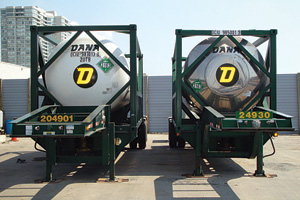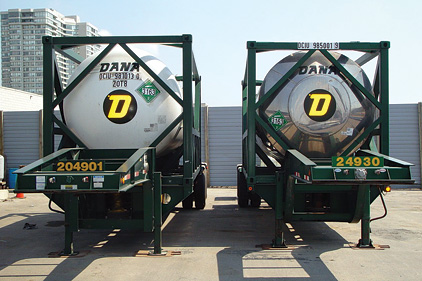
|
| Refrigerants are in transit for destruction. (Photo courtesy of Refrigerant Management Canada.) |
At some point, a refrigerant brought back for reclamation simply can’t be brought back to ARI-700 purity standards. There are a couple of approaches, including, destruction, which has a long track record, and, another option, conversion, offers a much fresher approach.
Seek and Destroy
The destruction of no-longer-useable refrigerants has been going on in Canada for years. The process is administered by Refrigerant Management Canada (RMC), a not-for-profit corporation established by the Heating, Refrigeration, and Air Conditioning Institute of Canada (HRAI). The group describes itself as an “industry-led environmental care program committed to the responsible disposal of surplus ozone depleting refrigerants from the stationary refrigeration and air conditioning industry.” A board of directors oversees the program’s operations and includes representatives from the refrigeration and air conditioning industry, equipment owners, and environmental/community groups.
In a statement made in 2012, RMC said it has successfully verified and registered 170,000 ozone depleting substances (ODS)-derived registered emission reductions (RERs) on the Canadian Standards Associations (CSA) reductions registry. RMC recognized these statistics as the first verification of a successful ODS destruction project in Canada.
RMC noted it has been overseeing destruction programs since 2000. “The initial verification of this achievement involved the successful quantification, registration, and serialization of the ODS sourced by RMC from across Canada and destroyed at the Swan Hills Treatment Centre in Swan Hills, Alberta,” it was announced.
“We are proud to have officially quantified and verified the significant greenhouse gas reductions that our heating and refrigeration partners have helped the RMC program achieve. Ensuring that these potent greenhouse gases — having some of the highest known global warming potential (GWP) values — are properly recovered and destroyed is the goal of our program,” noted Warren Heeley, president, RMC.
Following this first verification, RMC delivered 60,000 RERs to natural gas and electricity retailer Just Energy as part of a long-term sales agreement. “The revenue generated from the sale of these offsets is extremely important to the financial viability of our program and will help to ensure that ozone depleting substances in Canada are properly managed and destroyed,” he said.
Blue Source Canada, RMC’s offset project development partner, documented and quantified the project according to ISO 14064 Part 2 standards using a protocol adapted from the Climate Action Reserve. This work was verified by ICF Marbek, and subsequently registered on the Canadian Standards Association (CSA) reductions registry. “Blue Source is pleased to have worked with RMC to deliver this high-quality greenhouse gas reduction project and to contribute to the financial sustainability of this great Canadian environmental program,” added Yvan Champagne, president, Blue Source Canada.
“Just Energy is proud to be a part of this groundbreaking project, delivering high-quality credits for our customers,” said Ken Hartwick, president and CEO, Just Energy. “We’re also glad to support RMC, a great organization doing great work in the area of Canadian environmental care.”
Just Energy will incorporate the carbon credits as part of its carbon offset programs for residential and commercial customers. The company offers green energy solutions through its JustGreen™ and JustClean™ programs that enable customers to offset up to 100 percent of the emissions associated with their everyday energy use through carbon offsets as well as renewable energy projects.”
Midwest Refrigerants
In the U.S., one of the most recent advancements in dealing with refrigerants has come from the company Midwest Refrigerants and its conversion process.
Lew Steinberg, president, Midwest Refrigerants, said the company will be listed on the U.S. Environmental Protection Agency (EPA) website as an approved chemical-conversion facility once its first U.S. facility opens, which is expected in 2013. Steinberg also said that “since chemical conversion is considered part of the chemical manufacturing process, not destruction by combustion, and is environmentally more favorable, used ODSs are not subject to hazardous waste rules.”
Steinberg said the first Midwest Refrigerants conversion plant will be able to convert 2 million pounds (2.5MT) annually. And, he said, engineering has been completed for plants that can process up to 12-15 million pounds (5,500 to 7,500 MT) annually.
He cited approvals from the EPA and the United Nations. “We’ve now got all our patents issued, EPA approval, UNEP-TEAP approval, and construction of our first plant is under way,” said Steinberg. “The EPA will shortly list Midwest on its website of certified ODS destruction companies. They are actually creating a new category of ‘ODS Converters’ and we will be the only one.”
The technology is described as a “chemical reaction with hydrogen and carbon dioxide” that manipulates the unwanted ODS/greenhouse gas molecules and irreversibly converts them back into their original source chemicals, 99.99-plus percent anhydrous hydrogen fluoride, hydrogen chloride, and carbon dioxide, all for new uses such as hybrid car batteries and electronics.”
In the process, “Even virtually undetectable emissions are not atmospherically vented, as the Midwest system is a closed loop. There are no emissions, no waste streams, and the process is extremely energy efficient. The process is effective on CFCs, HCFCs, HFCs, PFCs, and HFOs. The process is also effective on halons, methyl bromide, and most POPS [Persistent Organic Pollutants].”
Publication date: 4/8/2013



Report Abusive Comment